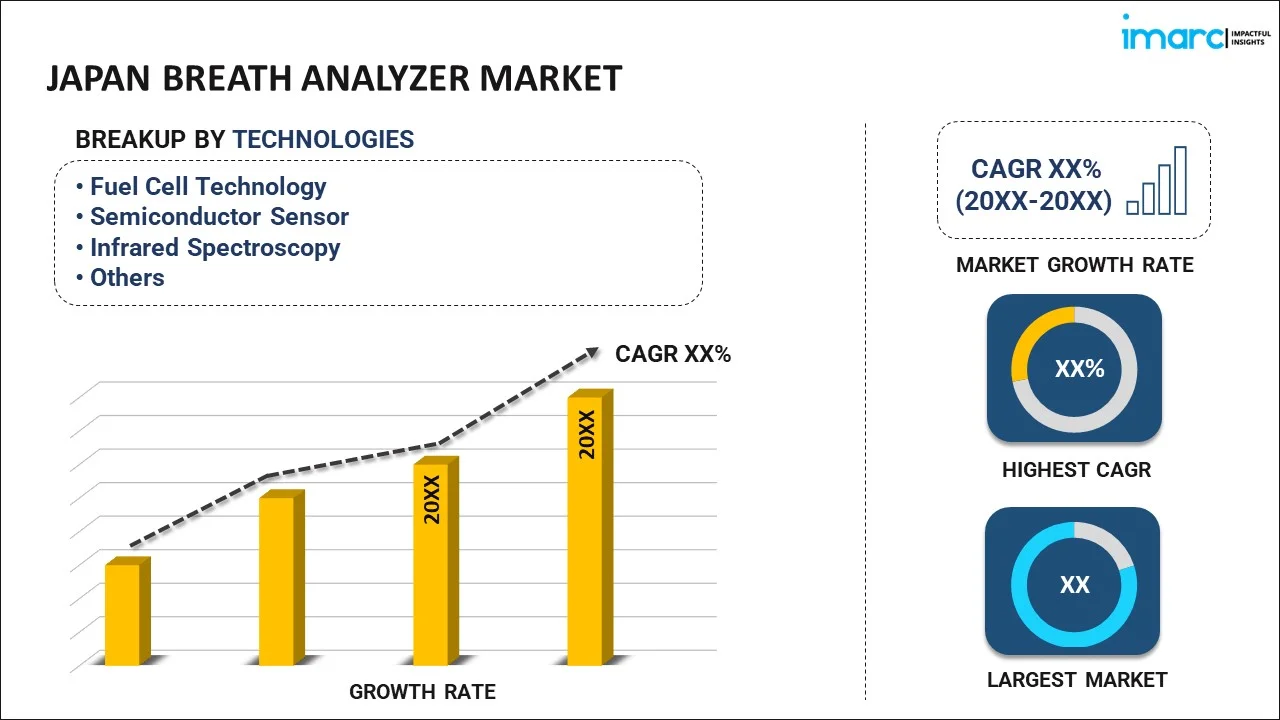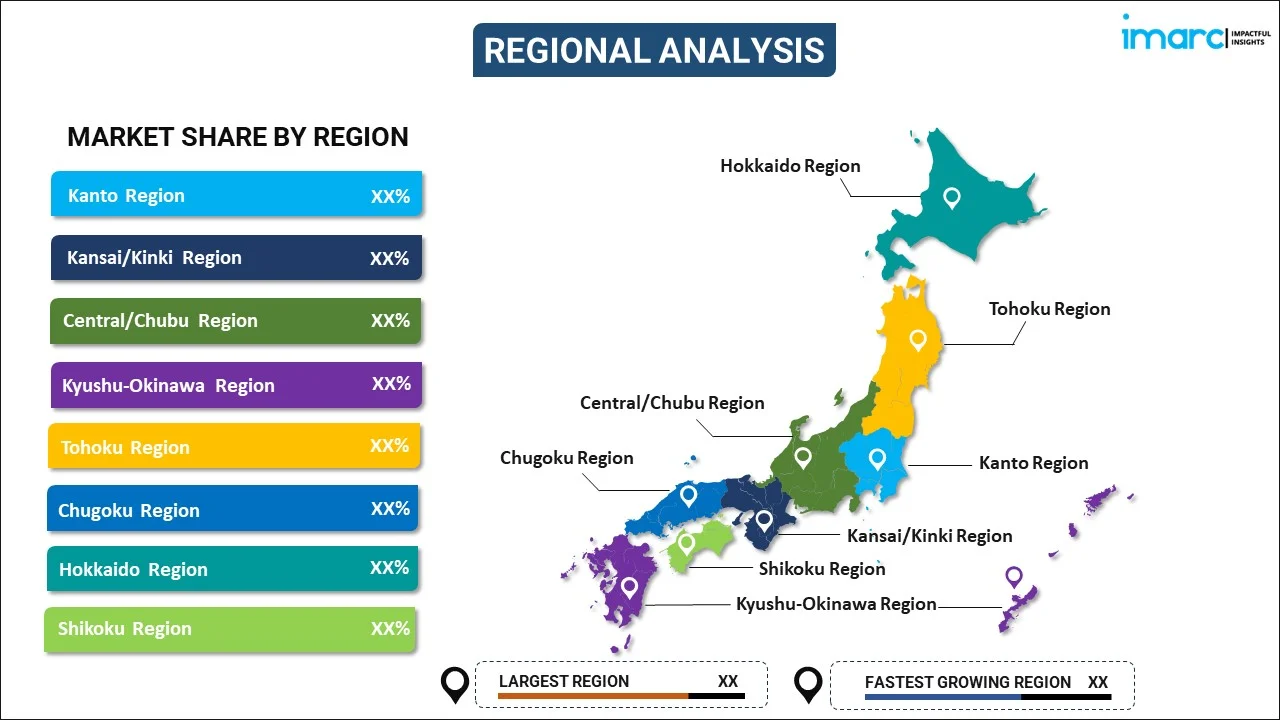
Japan Breath Analyzer Market Report by Technology (Fuel Cell Technology, Semiconductor Sensor, Infrared Spectroscopy, and Others), Application (Alcohol Detection, Drug Abuse Detection, Medical Application), End User (Law Enforcement Agencies, Enterprises, and Others), and Region 2025-2033
Market Overview:
Japan breath analyzer market size is projected to exhibit a growth rate (CAGR) of 13.5% during 2025-2033. The growing emphasis on public safety and awareness about the dangers associated with impaired driving, rising prevalence of alcohol and drug abuse, and increasing implementation of stringent legal regulations pertaining to alcohol and drug testing represent some of the key factors driving the market.
|
Report Attribute
|
Key Statistics
|
|---|---|
|
Base Year
|
2024 |
|
Forecast Years
|
2025-2033
|
|
Historical Years
|
2019-2024
|
| Market Growth Rate (2025-2033) | 13.5% |
A breath analyzer is a device designed to measure the alcohol content in the breath of an individual. It comprises evidential breath testers (EBTs), which are used by law enforcement and designed to meet strict legal standards for accuracy and reliability. It also includes preliminary breath testers (PBTs), which are handheld devices commonly used by law enforcement officers during traffic stops to provide a quick indication of impairment. It provides an objective and non-invasive method for determining impairment, reducing the subjectivity associated with field sobriety tests. It is quick and efficient, allowing law enforcement to screen many individuals during routine traffic stops. It operates on the principle of infrared spectroscopy, electrochemical fuel cells, or semiconductor sensors to detect and quantify the alcohol concentration in the breath of individuals. It helps prevent accidents and fatalities by identifying individuals who are driving under the influence of alcohol. It helps to protect both employees and the public from the risks associated with impaired workers in various safety-sensitive industries. It also assists in monitoring and supporting individuals in their recovery from alcohol addiction.
Japan Breath Analyzer Market Trends:
At present, the increasing emphasis on public safety and the awareness about the dangers associated with impaired driving represents one of the crucial factors impelling the growth of the market in Japan. Besides this, the rising prevalence of alcohol and drug abuse among the masses to cope with work stress and depression is contributing to the market growth in the country. In addition, the growing technological advancements and the integration of features, such as real-time monitoring, wireless connectivity, and smartphone compatibility of breath analyzers, are making them more user-friendly and effective. Apart from this, stringent legal regulations pertaining to alcohol and drug testing, and the rising number of road accidents and fatalities attributed to impaired driving, are compelling law enforcement agencies to adopt breath analyzers as a vital tool for ensuring road safety. Additionally, rising concerns about workplace safety and the need to maintain a drug-free working environment are driving the adoption of breath analyzers among employers, especially in industries wherein safety is of paramount importance. Moreover, advancements in sensor technology, including fuel cell-based and infrared sensors, are improving the accuracy and reliability of breath analyzers. This is also increasing the adoption of breath analyzers for clinical applications, such as monitoring alcohol levels in patients with alcohol use disorders and monitoring ketone levels in individuals on low-carb diets.
Japan Breath Analyzer Market Segmentation:
IMARC Group provides an analysis of the key trends in each segment of the market, along with forecasts at the country level for 2025-2033. Our report has categorized the market based on technology, application, and end user.
Technology Insights:

- Fuel Cell Technology
- Semiconductor Sensor
- Infrared Spectroscopy
- Others
The report has provided a detailed breakup and analysis of the market based on the technology. This includes fuel cell technology, semiconductor sensor, infrared spectroscopy, and others.
Application Insights:
- Alcohol Detection
- Drug Abuse Detection
- Medical Application
A detailed breakup and analysis of the market based on the application have also been provided in the report. This includes alcohol detection, drug abuse detection, and medical application.
End User Insights:
- Law Enforcement Agencies
- Enterprises
- Others
The report has provided a detailed breakup and analysis of the market based on the end user. This includes law enforcement agencies, enterprises, and others.
Regional Insights:

- Kanto Region
- Kansai/Kinki Region
- Central/ Chubu Region
- Kyushu-Okinawa Region
- Tohoku Region
- Chugoku Region
- Hokkaido Region
- Shikoku Region
The report has also provided a comprehensive analysis of all the major regional markets, which include Kanto Region, Kansai/Kinki Region, Central/ Chubu Region, Kyushu-Okinawa Region, Tohoku Region, Chugoku Region, Hokkaido Region, and Shikoku Region.
Competitive Landscape:
The market research report has also provided a comprehensive analysis of the competitive landscape. Competitive analysis such as market structure, key player positioning, top winning strategies, competitive dashboard, and company evaluation quadrant has been covered in the report. Also, detailed profiles of all major companies have been provided.
Japan Breath Analyzer Market Report Coverage:
| Report Features | Details |
|---|---|
| Base Year of the Analysis | 2024 |
| Historical Period | 2019-2024 |
| Forecast Period | 2025-2033 |
| Units | Million USD |
| Scope of the Report | Exploration of Historical and Forecast Trends, Industry Catalysts and Challenges, Segment-Wise Historical and Predictive Market Assessment:
|
| Technologies Covered | Fuel Cell Technology, Semiconductor Sensor, Infrared Spectroscopy, Others |
| Applications Covered | Alcohol Detection, Drug Abuse Detection, Medical Application |
| End Users Covered | Law Enforcement Agencies, Enterprises, Others |
| Regions Covered | Kanto Region, Kansai/Kinki Region, Central/ Chubu Region, Kyushu-Okinawa Region, Tohoku Region, Chugoku Region, Hokkaido Region, Shikoku Region |
| Customization Scope | 10% Free Customization |
| Post-Sale Analyst Support | 10-12 Weeks |
| Delivery Format | PDF and Excel through Email (We can also provide the editable version of the report in PPT/Word format on special request) |
Key Questions Answered in This Report:
- How has the Japan breath analyzer market performed so far and how will it perform in the coming years?
- What has been the impact of COVID-19 on the Japan breath analyzer market?
- What is the breakup of the Japan breath analyzer market on the basis of technology?
- What is the breakup of the Japan breath analyzer market on the basis of application?
- What is the breakup of the Japan breath analyzer market on the basis of end user?
- What are the various stages in the value chain of the Japan breath analyzer market?
- What are the key driving factors and challenges in the Japan breath analyzer?
- What is the structure of the Japan breath analyzer market and who are the key players?
- What is the degree of competition in the Japan breath analyzer market?
Key Benefits for Stakeholders:
- IMARC’s industry report offers a comprehensive quantitative analysis of various market segments, historical and current market trends, market forecasts, and dynamics of the Japan breath analyzer market from 2019-2033.
- The research report provides the latest information on the market drivers, challenges, and opportunities in the Japan breath analyzer market.
- Porter's five forces analysis assist stakeholders in assessing the impact of new entrants, competitive rivalry, supplier power, buyer power, and the threat of substitution. It helps stakeholders to analyze the level of competition within the Japan breath analyzer industry and its attractiveness.
- Competitive landscape allows stakeholders to understand their competitive environment and provides an insight into the current positions of key players in the market.
Need more help?
- Speak to our experienced analysts for insights on the current market scenarios.
- Include additional segments and countries to customize the report as per your requirement.
- Gain an unparalleled competitive advantage in your domain by understanding how to utilize the report and positively impacting your operations and revenue.
- For further assistance, please connect with our analysts.
 Inquire Before Buying
Inquire Before Buying
 Speak to an Analyst
Speak to an Analyst
 Request Brochure
Request Brochure
 Request Customization
Request Customization




.webp)




.webp)












